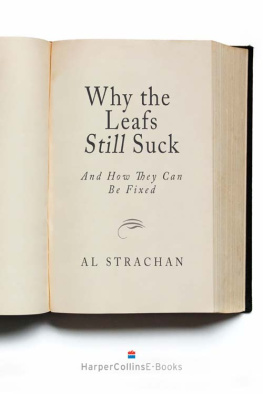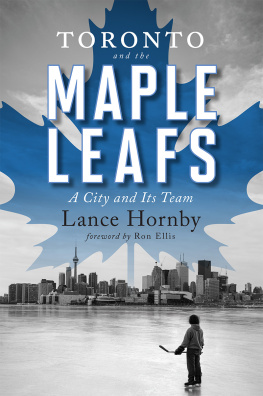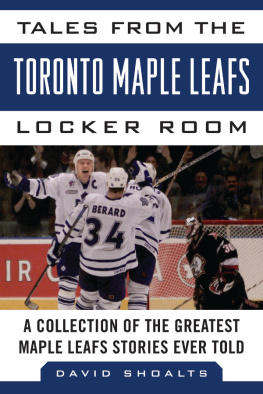Copyright 2014 by Maple Leaf Sports + Entertainment Ltd.
NHL, the NHL Shield, and the word mark and image of the Stanley Cup are registered trademarks of the National Hockey League. All NHL logos and marks and NHL team logos and marks depicted herein are the property of the NHL and the respective teams and may not be reproduced without the prior written consent of NHL Enterprises L.P. NHL 2014. All Rights Reserved.
The NHL Shield, team logos and player images are used under licence by Random House of Canada, Ltd.
All rights reserved. The use of any part of this publication reproduced, transmitted in any form or by any means, electronic, mechanical, photocopying, recording, or otherwise, or stored in a retrieval system, without the prior written consent of the publisher or, in case of photocopying or other reprographic copying, a licence from the Canadian Copyright Licensing Agency is an infringement of the copyright law.
Library and Archives Canada Cataloguing in Publication data available upon request.
Published simultaneously in the United States of America by McClelland & Stewart, a division of Random House of Canada Limited P.O. Box 1030, Plattsburgh, New York 12901
From left: Frank Mahovlich, Al Arbour, and Bob Pulford
CONTENTS
LEGEND: C = CAPTAIN

= HOCKEY HALL OF FAME MEMBER

= STANLEY CUP WINNER
INTRODUCTION
Our story starts about 100 years ago with a Stanley Cup win. Originally, the club was a temporary franchise operated by the Toronto Arena Company, the firm that owned the clubs home rink, the Arena Gardens. The existence of the Toronto team was a victory of pragmatism: the NHL had only three other teams, and some concessions had to be made for the burgeoning Toronto hockey market in what would be the first season of the league. The press called them the Blueshirts, or simply the Torontos.
The Arenas also known as the Blueshirts captured the 1918 Stanley Cup by defeating the Pacific Coast Hockey Association representatives, the Vancouver Millionaires, in five games. Because the series brought together teams from different leagues, an accommodation had to be made. The Pacific Coast league did not allow forward passing and played with seven players a side; the NHL permitted forward passing and played with six. And so for the best-of-five series, the rules alternated each game. Perhaps not surprisingly, each team won playing under their own rules, which set up a final game that was played under NHL rules. The Blueshirts final win of 21 earned a championship for Dick Carroll, a rookie coach who had been elevated from trainer a few months before the final. That victory was inscribed on the Cup 30 years later, cementing in history the successful inaugural season for the Toronto team.
From these modest beginnings, an allegiance has been forged. The Toronto Maple Leafs, whose trials and triumphs were delivered first via radio airwaves to kitchens and living rooms coast to coast, has given the hockey world some of its biggest names Apps, Kennedy, Bower, Salming, Sittler, Gilmour, Clark, Sundin Hall of Famers all of them. Thirteen Stanley Cups later, it has established itself as the most popular hockey team on the planet. Leafs Nation is now a borderless state that spans the globe, and the unflagging support of Leafs fans has no equal.
Within these pages are stories that come from a history rich in extraordinary players, exceptional coaches, and team builders. Their stories are pieces of a mosaic written in blue and white, victory and defeat, heartbreak and magnificent success.
MIKE ULMER
THE 1920 S
TEAM OF THE DECADE
192122 TORONTO ST. PATS

REGULAR SEASON RECORD: 13-10-1
PLAYOFF RECORD: 4-2-1
The Leafs predecessor, the Toronto St. Pats, garnered the citys first Stanley Cup thanks to a star who set a post-season scoring standard for the ages. Cecil Henry Babe Dye was the hero of the 1922 Stanley Cup. Dye scored 9 of the St. Pats 16 goals in the final over Vancouver, including 4 in the fifth and deciding game. His record 9 goals in that 1922 final has never been bettered.
Dyes 38 goals, struck in 29 games in the 192425 season, stood as the high-water mark for a Toronto player for 35 years until Frank Mahovlich scored 48 times in the 196061 season. Babe Dye led the league in goalscoring three times and was the NHLs top pointgetter in 1923 and 1925. No Leaf has won the scoring title since it was formalized into the Art Ross Trophy in 1948.
After losing two of the first three games, the St. Pats outscored Vancouver 111 over the final two contests to breeze to the citys second Stanley Cup.

Princess Elizabeth with Conn Smythe, 1951
CONN
SMYTHE
GENERAL MANAGER 192757  COACH 192731
COACH 192731
Born: February 1, 1895, Toronto, Ontario Died: November 18, 1980 (85), Toronto, Ontario
Games: 1,665 Record: 744 W, 612 L, 274 T Pts. %: .547
Stanley Cups: 1932, 1942, 1945, 1947, 1948, 1949, 1951
Inducted into Hockey Hall of Fame: 1958 (Builder)
The Toronto Maple Leafs are the product of one mans dream, a man who emerged from poverty to forge an institution on instinct, courage, and ambition. Conn Smythe was born into a poor Toronto family. While studying at the University of Toronto, young Conn was a bantamweight and played for the school hockey team.
Smythe fought in both World Wars. Though just five-foot-seven, he made a natural military man with his tenaciousness and single-minded determination. He won the Military Cross in 1916. After he was shot down and captured in an airborne mission, he made two aborted escape attempts and finished the war as a POW . He would be injured by shrapnel in the Second World War after cajoling his way into combat along with a regiment of athletes and writers he assembled. Smythe felt a kinship with fighting men. Of a hundred men in the army, you could trust ninety-five of them, he once said. From a hundred people in civilian life, youre lucky if you can trust five.











 = HOCKEY HALL OF FAME MEMBER
= HOCKEY HALL OF FAME MEMBER = STANLEY CUP WINNER
= STANLEY CUP WINNER



 COACH 192731
COACH 192731